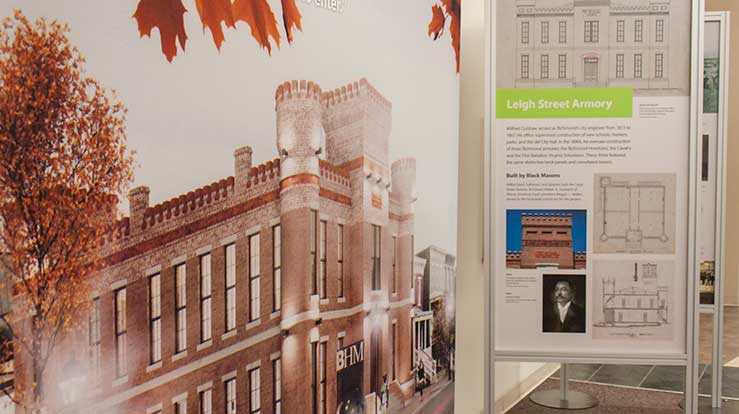Nation's First: Black History Museum exhibit explores Leigh Street Armory
November 3, 2014
An exhibit at James Branch Cabell Library tells a little-known story of the Leigh Street Armory, the nation's first African-American institution of its kind. Armories were common civic structures in their heyday at the turn of the century. They served as cultural centers and homes to local militia. The militia of this era fulfilled largely ceremonial functions.
The Leigh Street Armory in Jackson Ward opened in 1895. But, earlier, militia in the South had policed the slave states with violence and hatred. That the former capital of the Confederacy and a center of the slave trade, would be the first city to create an armory for blacks--while the Lost Cause movement still flourished and Jim Crow was emerging--is a fascinating footnote in Richmond's complex history.
This traveling exhibit from the Black History Museum and Cultural Center of Virginia unfolds the multi-layered story of the Leigh Street Armory: beginnings, military use, conversion to schools and community use and the present-day project as the future home of the museum and cultural center.
The exhibit is free and open to the public during library hours. Parking is available for a fee in the West Broad Street, West Main Street and West Cary Street parking decks. If special accommodations are needed, please call Gregory Kimbrell, membership and events coordinator, at (804) 828-0593.
The exhibit previously has been on view at Richmond City Hall, the State Library of Virginia and other locations. It will be up at Cabell Library through Dec. 13.
In their paper, "A Historic Jewel in Richmond Virginia: The Leigh Street Armory," scholar Roice Luke, Ph.D., and member of the board of directors of the Black History Museum and Culture Center of Virginia and Stacy Burrs, chair of the Black History Museum and Cultural Center of Virginia, offer this perspective of the significance of the building.
< Previous Next >"These [armories] are not mere historic relics of a military yesteryear, but, rather, the artifacts of a complicated and racially divided history in which our cities used militias to quell civil unrest (and, in the antebellum South, to suppress slave uprisings). Together, Richmond’s remaining two armories also serve as massive brick and stone reminders of how far the nation has yet to travel as it seeks to narrow its gnawing and persistent racial divide.
The armories also remind us of our country’s early efforts to balance the virtues of a standing army against the idealized image of homegrown, volunteer militias. They provide insight into what our founders might have been thinking when they inserted that now rather archaic word “militia” into our Constitution and the 2nd Amendment.
They also speak volumes about how in our past we expressed community, patriotism, and honor. The gallantly dressed and precisely disciplined militias and, in the late 19th century, their extravagant armories, were often at the center of America’s national, state and city celebrations and sense of pride. And, this was even truer for an African-American community that attributed to its black militias – and, in the case of Richmond, to the Leigh Street Armory – the illusory promise that “all men are created equal.”
Richmond itself is just beginning to explore the delicate interplay that in 19th century America existed between militias, armories and communities. The search for understanding, however, should be well worth the effort, as when completed this particular chapter should expand our understanding of not only this interesting, but little understood part of our city’s history, but also, more broadly, of the place our Commonwealth played in our nation’s racial history."
 Chat
Chat